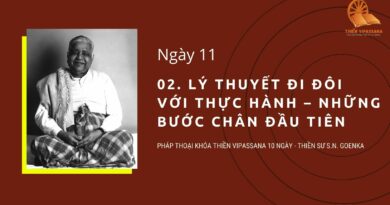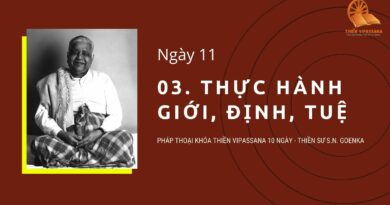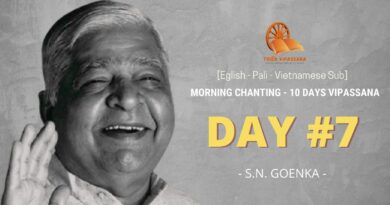“I recommend that every student of Vipassana learns at least basic Pāli, the words spoken by the Buddha. I speak from my own experience. Every word of the Enlightened One is so inspiring, provided you continue your meditation practice. You have to make your own research of the truth inside, research about the interaction of mind and matter inside—how out of ignorance, one keeps on reacting, how in wisdom, one comes out of it. This is how the words of the Buddha can be used for your own liberation” – S. N. Goenka
Introduction
VRI started imparting Intensive Residential Basic and Advanced training in Pali language for Indian and foreign students.
Apart from the publication of the Tipitaka along with its allied literature, preparation of the CD Chattha Sangayanaand Pali teaching, VRI scholars have published a large number of books which are prescribed in the Universities and Institutes as part of their curriculum.
The Government of India has recognized the Institute for training in Vipassana and for the teaching of Pali as the only institute of its kind, which integrates theoretical principles with the practice of Vipassana.
There is a great dearth of scholars in Pali language and literature, and thus it has become incumbent on VRI to prepare Pali scholars to further carry on research projects.
Since 1999, Department of Philosophy, University of Mumbai in collaboration with VRI has started a course, “Diploma in Teachings of the Buddha”. The course is divided into basic and advanced diploma. It has gained much popularity. These courses are open for meditators as well as non-meditators.
VRI has been conducting historical study of the origin, development, decline and revival of Vipassana Meditation. Additionally, comparative study between the Pali Tipitaka and the ancient Indian Literature like the Vedas, Upanishads and Jain Agamas is carried on with reference to techniques, concepts and terms. Some research areas are based on the influence of Vipassana on various aspects of day-to-day life.
The research publications and source materials have become the prescribed study material as a part of their curriculum in various Institutes and Universities where Pali and Buddhistic Studies are taught.
Details of Pali Study Programmes
Vipassana Research Institute offers the following Pariyatti-Patipatti courses for study of Pāli:
- Residential courses in the campus of Global Vipassana Pagoda
- Non-residential part-time diploma courses at Mumbai University
- Online Basic Pali workshop by VRI
Residential Course in Campus of Global Vipassana Pagoda
The Vipassana Research Institute offers an intensive three-month Pāli course for serious Vipassana meditators fully committed to the tradition of Sayagyi U Ba Khin as taught by Mr. S. N. Goenka. The programme provides an excellent opportunity for both the theory (pariyatti) and practice (patipatti) of Dhamma. The course introduces students to Pāli, the language in which the teachings of the Buddha are preserved. It does this in the environment of a meditation center, where the teachings are actually practiced. A 45 days Pali-Hindi course and a 75 days Pali-English course includes compulsory morning and evening group sittings. This combination of scholarly and meditative approaches makes the programme unique.
Residential Pāli Courses for 2020
| Sr. No | Start Date | End Date | Title | Educational Qualifications |
| 1 | July 4, 2020 (Saturday) |
August 18, 2020 (Tuesday) |
45 Day Basic Intensive Pāli – Hindi Course | Old SSC / HSC |
| 2 | September 5, 2020 (Saturday) |
November 4, 2020 (Wednesday) |
60 Days Basic Intensive Pāli – English Course | Graduation / Min. 15 years of education |
Eligibility Criteria for both Residential courses:
- Applicant must have completed three 10 day Vipassana courses and one Satipatthana course.
- One year regular practice of two hours at home daily.
- Observation of five precepts since last one year.
- Passing certificate of Educational Qualifications is a must.
- Recommendation by Area Teacher/Senior Assistant Teacher is a MUST. The AT Recommendation form is a part of the programme application form and must be signed by an AT who knows the applicant well.
- One passport size photograph.
(Note: Applicants must submit supporting documents with the form.)
To download the application form for the courses, please Click Here.
Part-Time Non-Residential Courses at VRI
Introduction to Vipassana Meditation
University of Mumbai (UoM) and Vipassana Research Institute (VRI) is jointly conducting the course on ‘Introduction to Vipassana Meditation’ covering the theoretical aspects and practical applicability of Vipassana Meditation in various fields.
Course Dates: 8th July 2020 to 23rd September 2020
Time: Every Wednesday, 01:00 to 4:00 pm (3 hours per week)
Eligibility: Min. HSC/Old SSC Pass
Venue: Vipassana Research Institute, Global Pagoda Campus, Gorai Village, Borivali (W), Mumbai. 400091
Fees: Rs. 1250/- (as per the requirement of Mumbai University)
Click here to download the application form. You may print, fill manually, scan and send it by email. Also, send your Educational Certificate & passport size photo with the Application form.
Abhidhamma in Daily Life 2020
Course In Progress
The following information will be applicable to all the courses listed above:
Venue: Vipassana Research Institute, Global Pagoda Campus, Gorai Village, Borivali (W), Mumbai. 400091
Email: for queries and sending application forms by email: mumbai@vridhamma.org.
Postal address for sending application forms: Vipassana Research Institute (VRI)
Global Vipassana Pagoda
Next to Esselworld, Gorai Village,
Borivali (West), Mumbai 400091,
Maharashtra, India
Tel.: +91 96192 34126 / +91 (22) 50427560 / +91 (22) 28451204 ext. 560 (9:30 AM to 5:30 PM only).
Non-Residential Part Time Diploma at Mumbai University
Part-Time One-Year Basic and Advanced Diploma Courses in the Teachings of the Buddha
The Buddha’s Teachings – Theory and Practice
Theoretical aspects and practical applicability of Vipassana Meditation in various fields
Eligibility: Old SSC/HSC
Applications available at: Department of Philosophy, University of Mumbai,1st Floor, Jnaneshwar Bhavan, Vidyanagari Campus, Kalina, Santacruz East, Mumbai 400 098
Admissions Date & Time: Tentatively in June 2020
For More Details kindly download the course brochure by clicking here.
You may also contact VRI for more information at the details given above.
Articles/Discourses by Mr S N Goenka on Learning Pāli
The Gem Set in Gold: Pariyatti with Patipatti
(The following article by Mr S N Goenka appeared in the Hindi language Vipashyanaa Patrika of January-February 1985. It has been translated and slightly adapted for Western students).
On 19 January, 1971 my dear Teacher, Sayagyi U Ba Khin, to whom I am ever grateful, passed away. It was always the deep wish of Sayagyi to help repay Burma’s debt to the Buddha and to the land of the Buddha, India, by reestablishing the Dhamma there in the country of its birth. He hoped that the Ganges of Dhamma, which long ago once flowed from India to Burma, could now be channelled back to the land of its source, in order to slake the thirst of millions of suffering people. A seedling from the tree of Dhamma which gives fruit in every season, had been transplanted centuries ago to Burma from India. The mother tree had withered, but the seedling had flourished and grown. Now a cutting must be taken from it and planted in the fertile soil of India, to give sweet fruit and cool, pleasant shade. And this invaluable jewel of the Indian heritage should also be shared with every land throughout the world
To realize this holy wish of Sayagyi, only a small step had been taken in his lifetime. In the fifteen years since he breathed his last, many more steps have been achieved, and if the progress at times was slow, it has been sure and steady. Now, with the gathering momentum of all these years of work, the time has come for the Dhamma to spread at greater pace. Up to now, centres have arisen in various places in India and abroad, and nearly fifty assistant teachers have started conducting courses for the good and happiness of many. Now still more courses must be offered in many more areas by more assistant teachers. Not only that, but meditators must be helped to experience the teaching at deeper levels.
I remember well my own experiences on the path. After I first learned the technique while living in Burma, I kept up a regular daily practice but had to devote much more of my time to my business and family responsibilities. Suddenly, however, there came a change in fortune: in 1964, the government took over all businesses and industries. This action, unfortunate for me in the eyes of others, was actually my good fortune, since a heavy burden was now lifted from my shoulders.
The following five years were the golden age of my life. I had always longed to study and absorb the words of the Buddha relating to Vipassana, but in the hurly-burly of active life how to find the time? Now here I was with unlimited time and with my Teacher close at hand. The result was that my practice took wing. In meditation I could go more deeply than ever before, and when I read the words of the Buddha I would feel a thrill of delight throughout my body. I felt sometimes as if the Buddha was speaking directly to me, as if every word was aimed specifically at me. At home, I would read a sutta and then go to my Teacher, who would take up certain points from it and expound deeply on them. This was a veritable shower of nectar, the nectar of the Dhamma.
Sayagyi, that incarnation of compassion, was always ready to discuss Dhamma with me. Even while sick in bed and badly needing rest, if he came to know that his Dhamma son was waiting to see him, compassion and joy arose in him and he would speak with me, explaining in depth a Dhamma text. As someone might card cotton or wool, combing out snarls and tangles, Sayagyi would remove all confusions, all ambiguities. The translations gave only grammatical explanations. But the explanation of this Vipassana yogi, this king of yogis, was of a different order altogether. He explained according to the experience of meditation, and in this way he could penetrate to the most profound meaning of the text.
His words always filled me with joy and inspiration. And then, after explaining Dhamma to me, he would tell me to go and meditate. At such a time I was able to penetrate deeply at the experiential level as well. Layer after layer of illusions and delusions would pass away, leaving the truth crystal clear. By the time I rose from meditating I would feel freed of all knots, liberated from all confusion.
From these experiences boundless gratitude would arise in me, firstly to the Buddha and then to his Dhamma sons, the chain of teacher and pupil extending link by link from the Buddha to Sayagyi U Ba Khin. To all of them I felt deep gratitude for preserving this technique in its original purity without any admixture whatsoever. At the same time gratitude would arise in me towards all those who had preserved the words of the Buddha free from any corruptions, so that today it is still possible to read them and be inspired by them. Pariyatti and patipatti—study accompanied by practice—these two seemed to me like a gem, the beauty of which is enhanced by its golden setting.
How greatly I benefited from these experiences, yet how little are such experiences accessible to meditators today! Although the Pāli Tipiṭaka has appeared in Devanagari script in India, for many years these books have been out of print. Further, whatever portion of the Tipiṭaka was translated into Hindi decades ago is also unavailable now, while little if anything has been translated into other Indian languages. Meditators in India are, therefore, cut off from the words of the Buddha.
In the West, it would seem that students are more fortunate, since the entire Tipiṭaka has appeared in Roman script and has been translated into English. But, in fact, the passages of it relating directly to meditation have presented unusual difficulties to most scholars. These passages have been translated in a way that many a time could create confusion in the minds of meditators who read them.
When students participate in courses on the Satipaṭṭhāna Sutta, studying the words of the Buddha while at the same time applying them in meditation, they are inspired and filled with gratitude. They feel as if the technique is revealed to them for the first time in all its brilliant clarity. Naturally they would like to study even more. How happy they would be if they could study in their own language, not only the Tipiṭaka, but also the voluminous literature of the commentaries!
It is not expected or necessary that all should be motivated to study the texts, but certainly there are many who are able and eager to do so, who could plunge easily into the ocean of the Tipiṭaka. For them the opportunity must be provided.
And not only the Pāli texts but also those in Sanskrit and Prakrit contain references to Vipassana. If a meditator undertakes the necessary research, this technique will be revealed as the essence of the entire Indian spiritual tradition.
It is a large task, no doubt, but the time has come to make a beginning no matter how small.
Doing so, however, must never be at the expense of meditation practice. Otherwise, Vipassana centers might degenerate into places where people merely read, write or talk about the Dhamma, and the real purpose might be lost. Our aim is always to experience the Dhamma within ourselves in order to emerge from all suffering. And the means to do so is the practice of Vipassana meditation. Reading, writing and study are merely to find guidance and inspiration in order to go more deeply in the practice, and thus to come closer to the goal of liberation.
Without sacrificing this object, opportunities should be created near all the centers for pariyatti, study of Dhamma. And it must begin at the main center, Dhammagiri. At the foot of the hill, on the approaches to the Academy, is a suitable place to establish facilities for the study of Pāli and for research on the original texts. All who participate, not only students but also teachers, must be regular meditators, and meditation must be an important part of the curriculum. If this is the case, their study will enable the participants to meditate more deeply and experience Dhamma more profoundly within themselves.
May the lofty example of Sayagyi U Ba Khin give you inspiration for still greater efforts in Vipassana throughout this year, for your own benefit and for the good and benefit of many.
Kalyānmitta S. N. Goenka
(Courtesy: International Vipassana Newsletter, April 1986 issue)
Words of Mr. S. N. Goenka on research and Pāli learning
Now about research: The words of the Buddha are lost in many countries, and we should be grateful to the countries that maintained them in their pristine purity.
These words of the Buddha have to spread in order to help paṭipatti[meditation practice]. The pariyatti [theory], the publication of pariyatti, the research in pariyatti should not become our main aim. Our main aim will always be paṭipatti. If we remain satisfied only with reading the words of the Buddha, but do nothing to take steps on the path he taught, then again we have started harming ourselves. The theoretical aspect of Dhamma, the words of the Buddha, are to help us, to encourage us, to guide us, but the main thing will always be to walk on the path step by step. Make use of the words of the Buddha and they will certainly encourage you.
I recommend that every student of Vipassana learns at least basic Pāli, the words spoken by Buddha. I speak from my own experience. Every word of the Enlightened One is so inspiring, provided you continue your meditation practice. You have to make your own research of the truth inside, research about the interaction of mind and matter inside—how out of ignorance one keeps on reacting, how in wisdom one comes out of it. This is how the words of the Buddha can be used for your own liberation.
Suffering is all around, misery is all around. May this wonderful medicine of the Buddha help the suffering people to come out of their illness, to come out of their misery. May the light of Dhamma spread around the world, dispelling the darkness of ignorance.
Bhavatu sabba maṅgalaṃ
Experiences of Pāli Students
The Experiential Aspect of Dhamma
(The following was written by Dr. (Mrs.) Chandrasheela Shakya in January, 1984. Dr. Shakya is a Pāli scholar based in N.E. India and Nepal. (Pāli is the language used in the Tipitaka, the original texts of Theravadin Buddhism.) She was appointed as an assistant teacher to S.N. Goenka in 1983 and has conducted a number of courses jointly with Dr. Vithal Dus Modi).
After having completed a number of courses at Dhammagiri under the guidance of S.N. Goenka, I have come to a new realization of the intent and meaning of so many of the words and teachings of the Buddha. These courses have enabled me to reassess my own intellectual understanding of the Pāli language and its literature and to see that their real meaning can only be made clear if it is learned through actual practice in the way in which the author wanted them to be practiced.
I myself have completed a Ph.D on “The Critical Study of the Dighanikaya” (Collection of Long Discourses of the Buddha) at Banaras Hindu University. As such, I am very familiar with the theories of this field of study and with the various commentary, lexicological and linguistic works which have been done as well. But now, my research at the experiential level through the method taught at Dhammagiri has convinced me that I was, in fact, far from the actual meaning of what the Buddha wanted to convey. Interestingly enough, I have found that this is also the experience of many other students who have completed these same courses, including other Pāli scholars like myself. The Buddha himself indicated this when he said that pariyesanā (complete research) is actually sevitabba bhavitabba (at the experiential level). I find that, until recently, all of the modern research into the Buddha’s words has actually been asevitabba and abhavitabba (non-experiential). Unfortunately, the experiential aspect of experimenting with the truth of the Buddha’s words has been totally missing. Although I realize that the intellect is an extremely important factor for research, nevertheless without personal experience, the words of an enlightened person like the Buddha cannot be properly understood. Because I am a scholar and because I have made scholarship and research the central endeavor of my life and my career, I find it very exciting to learn that the academy at Dhammagiri is taking the proper approach to this important research.
Pāli, the language of the Buddha, is already a dead language. Because of this fact, the glorious cultural heritage of our country and our countrymen is not properly understood by Indians in general. The important work being done at Dhammagiri will bring out the glory of this invaluable cultural heritage and make it comprehensible, not only to our own countrymen, but to the world at large. From the purely linguistic point of view, this research will enrich and elucidate much of our understanding of the origin and roots as well as the historical development of our own modern Indian languages. Not only the teachings of the Buddha but the language itself is of inestimable value in understanding our cultural heritage. As a scholar, I am impressed, and at the same time pleased, that this is being done in a completely scientific and non-sectarian way.
My own orientation has been to the language and literature of the Buddha, but I believe that scholars of other religions who have done courses at Dhammagiri have had similar experiences in their own academic disciplines. Because the method taught at Dhammagiri is completely devoid of any sectarian orientation, the way in which people experience the words of the Buddha inside themselves has given much understanding and special insight to people of various religions and philosophies; even into their own scriptures and saintly authors. People have found new and clearer meanings in the Vedas, the Gita, and the Upanishads. Even Jain scholars have been impressed with the fresh understanding they have achieved in the Āgamas. I have also heard that many Christians and Muslims who complete courses at Dhammagiri and whose religions are not Indian in origin have also been surprised by the new meanings which they find in the Bible and the Koran.
By my own research and experiments at Dhammagiri, I am convinced that actuality at the experiential level is far different from the intellectual. Vipassanā meditation gives us the opportunity to experience this reality for ourselves.
(Courtesy: International Vipassana Newsletter June 1985 issue)
Nguồn VRIDhamma.org




